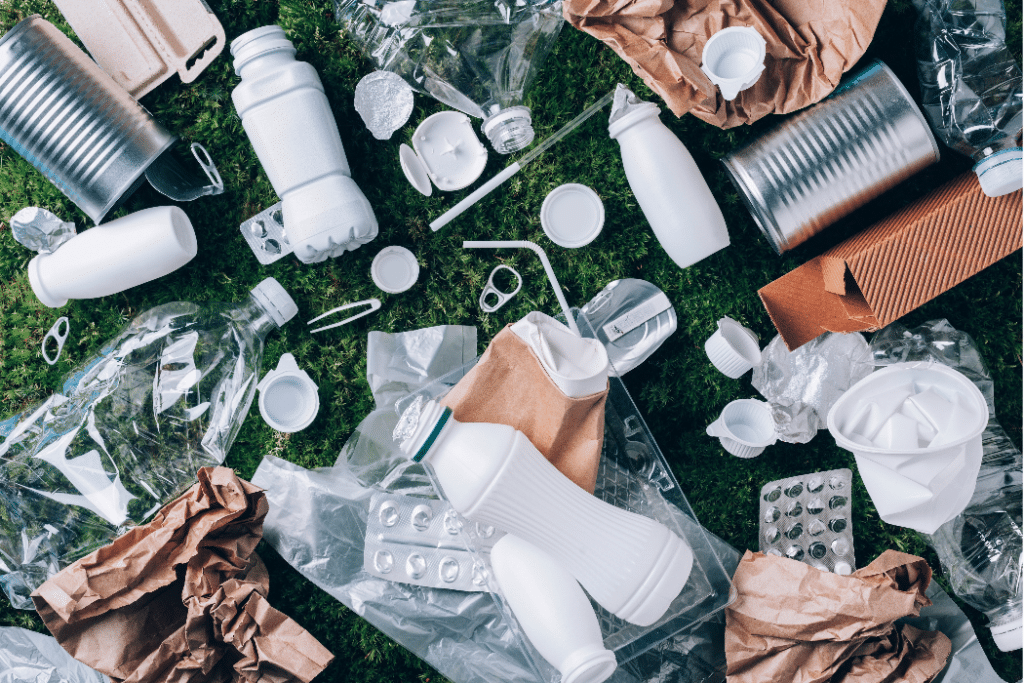Did you know that every minute, one million plastic bottles are bought around the world (1)? That’s a mind-boggling number! More shockingly, many of these products contain a sneaky chemical called Bisphenol A, or BPA. This compound has sparked concern, debates, and tons of research. So, what’s the big deal about BPA, and why are more products proudly sporting a “BPA-free” label? Join us as we explore what BPA is and discuss its significance in your everyday items.
What is BPA?
BPA, or Bisphenol A, is a chemical compound primarily used to make certain plastics and epoxy resins (2). It is often a key component in plastic manufacturing, enhancing toughness and durability.
BPA wasn’t always in your water bottles or food containers. In the early 20th century, chemists first synthesized it in the search for synthetic estrogens (3). Yes, you read that right – BPA was originally explored for its hormonal properties! However, by the 1950s, industries recognized its potential in plastic manufacturing and began integrating it into consumer products. From potential medical applications to being a household staple, BPA has had quite the journey.
Why is BPA Bad?
BPA, or Bisphenol A, is concerning due to its role as an endocrine disruptor, meaning it can mimic or interfere with the body’s natural hormones (4). This interference has been associated with:
- A heightened risk of certain cancers, notably breast and prostate (5).
- Brain and behavioral challenges, particularly in younger populations.
- Heart-related complications.
- Potential issues with obesity and fertility (6).
Our endocrine system is like the body’s communication network. It sends out hormones – chemical messengers – to regulate everything from mood to metabolism. BPA can imitate our body’s hormones, especially estrogen, leading to a imbalance in the endocrine system. This imbalance is what leads to the health issues mentioned above.
While the debate about its safety thresholds continues, one thing is clear: It’s probably best to play it safe and limit our exposure whenever possible.
What Products Contain BPA?
BPA is commonly found in polycarbonate plastics – the stuff of which many everyday items are made of. Here’s a quick rundown of common items that might contain BPA:
Here are some products that may contain BPA:
- Water Bottles
- Food Cans (internal lining)
- Sports Equipment, particularly items like helmets and goggles
- Bottle Tops
- Water Supply Lines (coating)
- Receipts
- Eyeglass Lenses
- Cosmetic Jars
- CDs and DVDs
Awareness is the first step towards making informed decisions. As BPA concerns grow, many manufacturers now produce BPA-free alternatives, highlighting the importance of checking labels and choosing wisely.
Why is BPA-Free Plastic Good?
BPA-free plastic is considered superior because it reduces the health risks linked with BPA exposure, such as potential hormone disruption, cancers, and brain issues. By opting for BPA-free products, consumers can enjoy safer goods, free from these concerns.
Benefits of BPA-Free Products:
- Health Safety: BPA-free items provide a shield against hormone-related disturbances, certain cancers, and behavioral anomalies.
- Protection for Sensitive Groups: BPA’s effects are more pronounced in infants, children, and pregnant women (7). BPA-free alternatives ensure their safety.
- Environmental Impact: Many BPA-free plastics are eco-friendly, boasting a reduced carbon footprint and improved recyclability.
Promotes Industry Change: The shift towards BPA-free standards spurs innovation in safer, sustainable materials.
Is BPA-Free Plastic Safe?
BPA-free plastic means the product doesn’t contain the chemical Bisphenol A, known for its potential health risks. While this sounds reassuring, some BPA-free plastics might contain alternative chemicals that have their own sets of concerns. Consumers should be informed about other chemicals present and select products from reputable brands.
What to watch out for:
- BPS & BPF: Some manufacturers have replaced BPA with its chemical cousins, BPS (Bisphenol S) and BPF (Bisphenol F). Preliminary studies hint that these might share similar health concerns with BPA (8).
- Beyond BPA: Plastics may contain other chemicals, such as phthalates, that raise health concerns. A “BPA-free” label doesn’t necessarily mean “chemical-free.”
- The Constant Evolution of Plastics: Plastic safety is a dynamic field of study. As one harmful chemical becomes well-known, other potentially harmful ones may emerge. Being informed is the best defense.
While BPA-free is a step toward safer consumer products, it’s always wise to scrutinize what other chemicals might be in the mix.
Are BPA-Free Products More Sustainable?
The pivot towards BPA-free plastics isn’t just about health; it’s also part of a broader movement towards more sustainable, eco-friendly choices. Materials without harmful chemicals like BPA can be safer for the environment. Think about it: less chemical leaching into the soil and water means healthier ecosystems.
But what about the life cycle of these plastics? That’s where recycling steps in:
- BPA Plastics: Plastics containing BPA, primarily polycarbonates, are labeled with the recycling code “#7”. Not all of them are recyclable in typical municipal recycling programs. When they are, the recycling process must be meticulous to prevent BPA leaching, adding to the complexity.
- BPA-Free Plastics: Many BPA-free plastics come under different recycling codes, depending on their chemical composition. For example, PET (polyethylene terephthalate), a common BPA-free plastic used in drink bottles, carries the recycling code “#1” and is widely accepted in recycling programs. This means more of these plastics might get a second life instead of languishing in landfills.
Keep in mind that sustainability isn’t just about picking BPA-free products — it means also ensuring that they are disposed of responsibly.
The Road Ahead: BPA, Health, and Sustainability
Our journey through the intricacies of BPA reveals a broader story about health, sustainability, and our collective efforts for a safer future. Here’s a quick snapshot of what lies ahead:
Ongoing Research
The story of BPA isn’t fully written yet. Labs worldwide continue to investigate BPA’s long-term effects and search for safer alternatives.
Global Initiatives
Countries are stepping up. There’s a global push for clearer regulations on chemical use and a demand for more transparent industry practices. This signifies a shift towards a safer and sustainable global market.
What’s Next for You?
Stay informed. Your choices matter and can drive meaningful change. If you’re interested in diving deeper, explore our collection on sustainable living and eco-friendly choices. Continue educating yourself and making thoughtful choices. Your actions today shape our world tomorrow.
References
- “Beat Plastic Pollution.” UN Environment Programme. https://www.unep.org/interactives/beat-plastic-pollution/
- “Bisphenol A (BPA).” NIH, 2023. https://www.niehs.nih.gov/health/topics/agents/sya-bpa/index.cfm
- “The Politics of Plastics: The Making and Unmaking of Bisphenol A ‘Safety’.” American Journal of Public Health, 2009. https://www.ncbi.nlm.nih.gov/pmc/articles/PMC2774166/
- “Endocrine Disruptors.” NIH, 2023. https://www.niehs.nih.gov/health/topics/agents/endocrine/index.cfm
- “Bisphenol A and Hormone-Associated Cancers: Current Progress and Perspectives.” Medicine, 2015. https://www.ncbi.nlm.nih.gov/pmc/articles/PMC4602822/
- “The Impact of Bisphenol A on Fertility, Reproductive System, and Development: A Review of the Literature.” International Journal of Endocrinology, 2019. https://www.ncbi.nlm.nih.gov/pmc/articles/PMC6481157/
- “Mom’s Exposure to BPA During Pregnancy May Put Her Baby on Course to Obesity.” Columbia University, 2016. https://www.publichealth.columbia.edu/news/moms-exposure-bpa-during-pregnancy-may-put-her-baby-course-obesity
- “BPA-Free Plastic Containers May Be Just as Hazardous.” Scientific American, 2014. https://www.scientificamerican.com/article/bpa-free-plastic-containers-may-be-just-as-hazardous/




